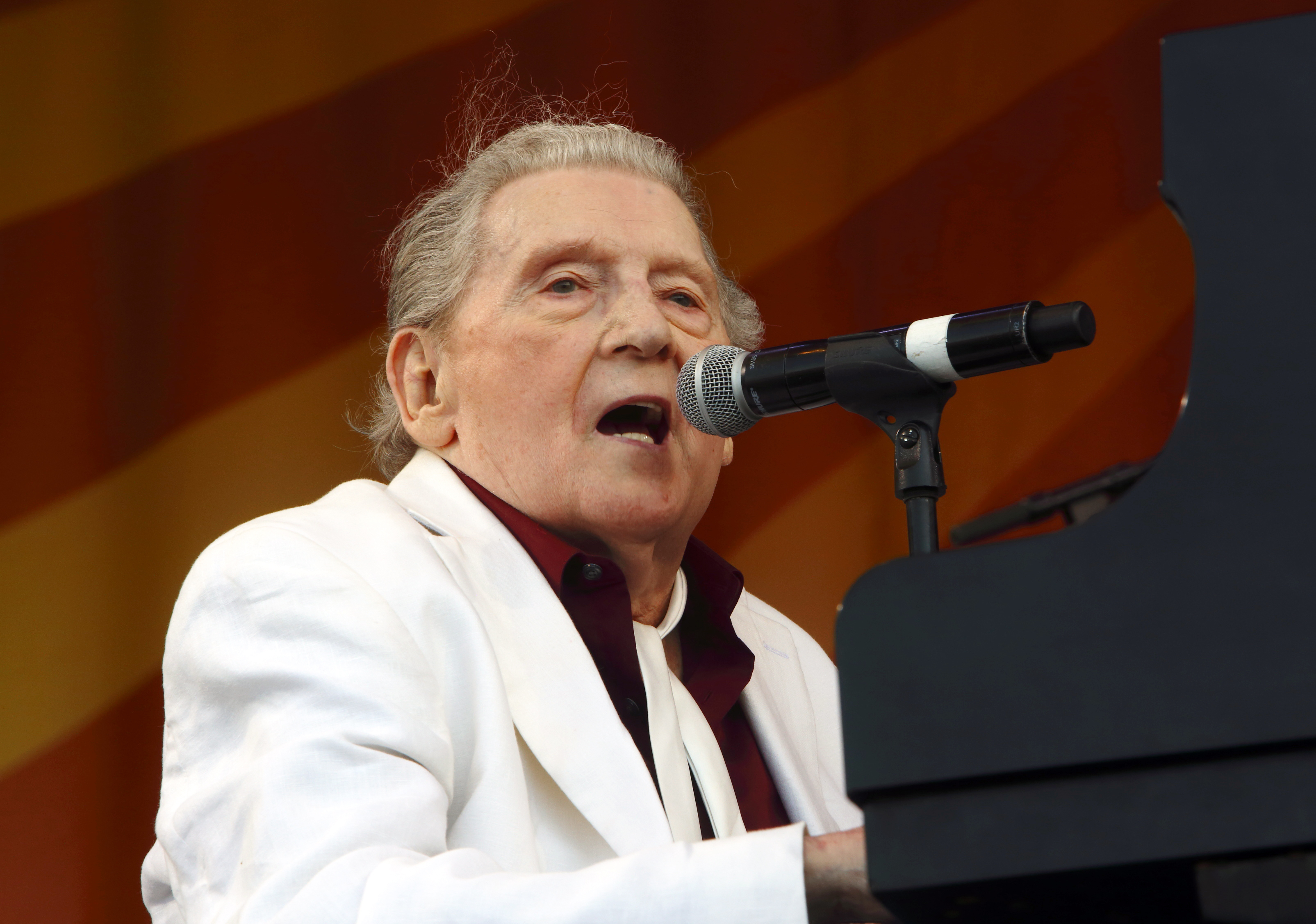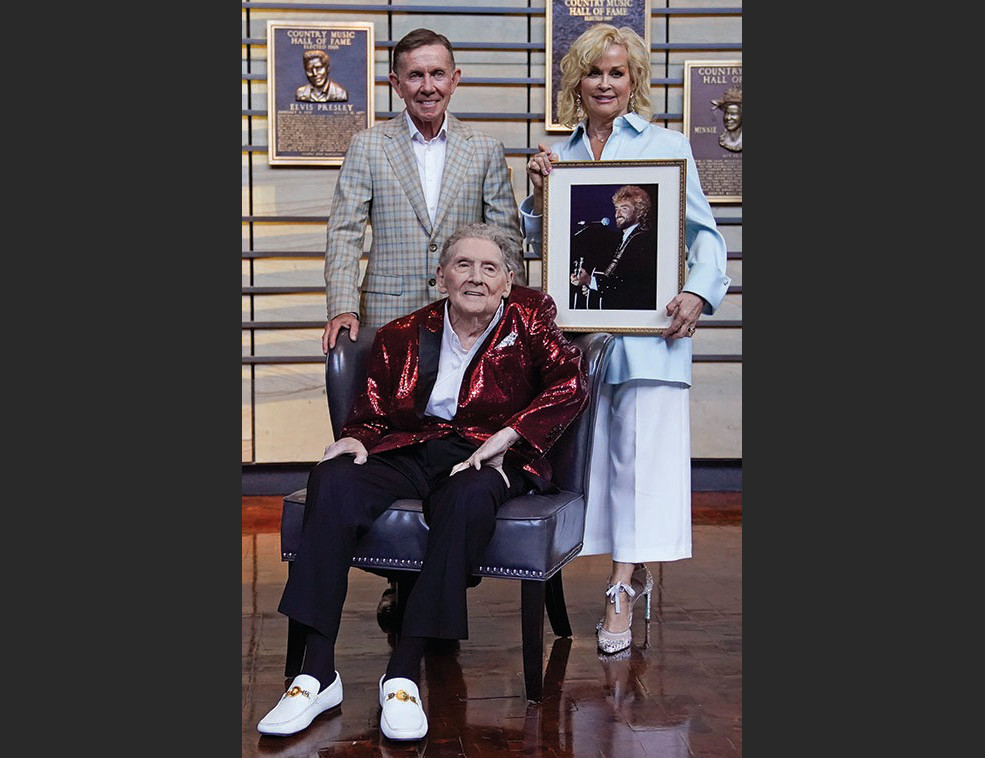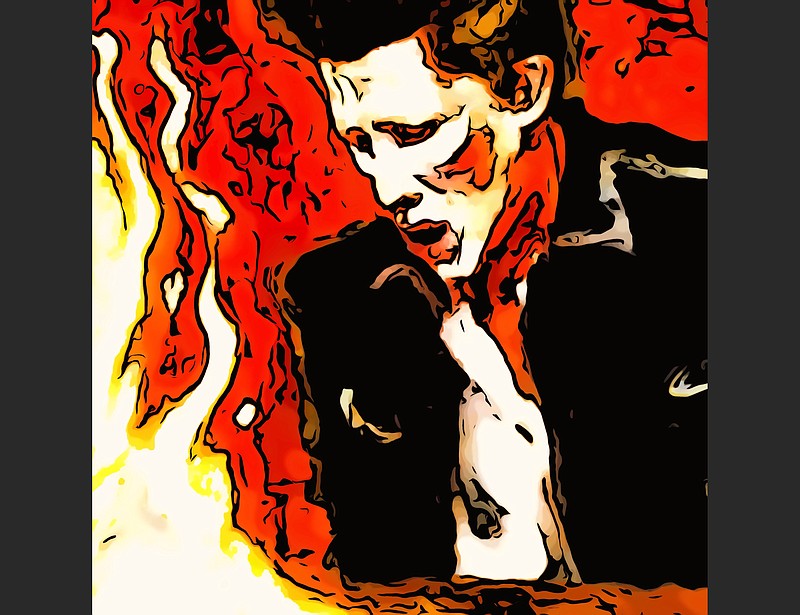- "There has never been another American pop musician with Lewis' particular mixture of egotistical self-confidence, innate taste and sensitivity, eclecticism ... formidable and entirely idiosyncratic technique (both instrumental and vocal) and sheer bravura."
- — Robert Palmer, "Blues & Chaos: The Music Writing of Robert Palmer"
If Jerry Lee Lewis had the theology right, the ol' boy is roasting in hell right now.
He was, after all, "the Killer," and the stench of death was never far from him. Maybe he never actually turned out anybody's lights, but was very likely a proximate cause of death of at least one (maybe two) of his seven wives. He was a child abuser, a wife beater, an abandoner of families. He shot a bass player in the chest too, but that was just reckless; boys having fun with a .357 Magnum.
It seems hard to believe it now, but there was a time, in the '70s and early '80s, when you could see a lot of the first wave of rock 'n' roll boys at county fairs and in Veterans of Foreign Wars halls. I saw Lewis play for a $2 cover a few times. And all the things they say about him were true; nobody played piano like him — that two-handed concussive boogie woogie with the jittering bass in the left hand — and nobody felt the spirit like that stool-kickin' madman.
Lewis was technique and intuition married to energy and showmanship, and more than any other first-generation rocker he was committed to the devil inside.
Chuck Berry was a savvy businessman, feeding a white teenage audience songs about themselves. Elvis was the would-be crooner who wanted to transition from the greasy kid stuff and have a Dean Martin-style movie career. Johnny Cash was never a rocker; he was a monument, an American Rasputin, a three-chord prophet torn between the appetites of the flesh and a shakeable but abiding faith in both his earthly purpose and his eventual salvation. Little Richard vacillated between his nature and the way he thought his God wanted him to be. But Lewis took the pen and signed on the dotted line — he knew his soul was toast.
He was committed, a true believer who understood the magnitude of his sins. He knew he was damned and there was nothing short of begging forgiveness that could save him. The Killer didn't beg. He'd go to hell and run the commissary before he'd ask anyone for forgiveness. There was a meanness in him. He wasn't fake showbiz pretend — Jerry Lee Lewis was malevolent.
Maybe that's what made him great.
[Video not showing above? Click here to watch: arkansasonline.com/116gbof]
KEEP A KNOCKIN'
He died last week. The last man standing — the last OG (original gangster) rock 'n' roller.
I remember him more as a country artist — "What Made Milwaukee Famous (Has Made a Loser Out of Me)" occupies more space in my head than either of the two songs by him that everybody knows, "Whole Lot of Shakin' Going On" and "Great Balls of Fire," but that has more to do with my age and the radio habits of my parents than it does with the consensus legend of Jerry Lee Lewis.
Before that 1968 Nashville renaissance, Lewis had been hitless for seven years, having last appeared on the charts with a cover of Ray Charles' "What'd I Say" in 1961. He'd been touring nonstop trying to regain traction after his marriage to his 13-year-old cousin Myra Gale Brown (technically, she was his second cousin; Lewis ' grandmother and Myra's great-grandmother were the same person) in 1957.
While the story has been told many times, it bears repeating. While not yet divorced from his second wife, Lewis began "messing around" with 12-year-old Myra, the daughter of Lewis' cousin and bass player J.W. Brown (not the bass player Lewis shot twice in the chest in 1976; that would be Norman "Butch" Owens). In Lewis' version, after a particularly enjoyable evening spent in the back seat of his car, he decided to marry Myra, who by then had turned 13.
"She was a woman," Lewis told his authorized biographer Rick Bragg for his 2012 book "Jerry Lee Lewis: His Own Story." "She looked like a grown woman, blossomed out and ready for plucking."
Ick.
To put everything in context, Lewis' people were the early marryin' kind. His sister was married twice before she turned 16. Lewis had first married at 16, to 17-year-old Pentecostal preacher's daughter Dorothy Barton. It was a regular ceremony, held in the home of Lewis' uncle Lee Calhoun, a prominent Ferriday citizen who owned a plantation and several local businesses. It was covered in the society pages of the the Ferriday newspaper.
About a year later, while still married to Dorothy, he'd been tracked down by the horsewhip and pistol-totin' brothers of Jane Mitcham, a 17-year-old he'd met at a Natchez, Miss., roller skating rink, who explained to him that Jane was pregnant and that Lewis had to marry her.
 Jerry Lee Lewis performs at the New Orleans Jazz & Heritage Festival in New Orleans in this 2015 file photo. (Invision/AP/John Davisson, file) MATRIMONIAL TANGLES
Jerry Lee Lewis performs at the New Orleans Jazz & Heritage Festival in New Orleans in this 2015 file photo. (Invision/AP/John Davisson, file) MATRIMONIAL TANGLES
In "Hellfire," Nick Tosches' highly entertaining 1998 biography of Lewis, he contends that two of Jane's brothers did not want Lewis to marry their sister. They just wanted to murder him. Tosches says Uncle Lee dissuaded them, but couldn't save his nephew from bigamy. Lewis and Jane were married in Fayette, Miss., on Sept. 10, 1953. He filed for divorce from Dorothy on Oct. 8.
Lewis had lied on both his marriage certificates — he claimed he was 22 when he married Dorothy; he claimed he was 21 when he married Jane. Obviously he had a fairly casual attitude about marriage and about abandoning his wives and children; he had two with Jane, Jerry Lee Jr. — who died in a single-vehicle accident when he was 19 — and Ronnie Guy, whom for years Lewis refused to acknowledge.
Lewis had to marry Myra twice; the first ceremony took place before his divorce from Jane was finalized and was a clandestine affair. Lewis went to Mississippi with an older female friend to procure a wedding license, on which Myra claimed to be 20 years old. They were married in secret, without any family or friends in attendance, by a shady justice of the peace. After the wedding, Lewis dropped Myra off at her parents' house, and it was a few days before their secret came out. (Myra later wrote that she "got a whoopin'" from a none-too-thrilled J.W.)
They had to do it all over again six months later.
Lewis and Myra settled into domestic tranquility in a new house south of Memphis. A few weeks later, Lewis embarked on his first overseas tour to England. He brought his wife and his father-in-law bass player with him. And in London, Daily Mail reporter Paul Tanfield asked the little girl who was part of Lewis' entourage what she was doing there.
"I'm Jerry's wife," she said. (Later she'd tell an American reporter that, where she came from, you could "get married at 10 if you could find a husband.")
Lewis confirmed the story that afternoon, though he told reporters his 13-year-old bride was 15 years old; maybe because the age of consent in the United Kingdom had been 16 since 1885. It didn't help. Repressed '50s Britain was scandalized. Jerry Lee Lewis was an authentic hillbilly, complete with a child bride straight out of Tennessee Williams' play "Baby Doll."
Lewis' career, which had only begun to catch fire, seemed to be over.
[Video not showing above? Click here to watch: arkansasonline.com/116shakin]
BORN DIRT POOR
Lewis was born to dirt-poor people, a step up from sharecroppers, in East Louisiana during the Depression. Yet his parents recognized his talent early, and after an early dalliance with the guitar (an instrument Lewis found "limiting"), they mortgaged their farm to buy him a cheap piano. Elmo, his father, played a little piano; he was moved when he heard his son sit down and pluck out a version of "Silent Night" at a neighbor's Christmas party. Being poor does not make one a rube or insensitive to talent.
Along with two cousins, Jimmy Swaggart (later the famous televangelist) and Mickey Gilley (later a country music singer and nightclub proprietor), he began exploring the sonic possibilities of the instrument. (They all learned on the same piano.) He was influenced by the sounds emanating from Haney's Big House, a Black juke joint owned by his rich uncle Lee (who consequently may have allowed the underage Lewis the run of the place). Sometimes he said hillbilly pianist Moon Mullican was his biggest influence.
Other times he said Moon Mullican couldn't "influence a toilet."
His family was not so poor that they did not have a radio — Lewis heard Hank Williams, Gene Autry and Jimmie Rodgers, and could play back what he heard instantly. (Much later, he'd say there were only four originals in American pop music: Williams, Rodgers, Al Jolson and the Killer himself. "I'm a stylist," he'd growl. "I never copied nobody.")
Lewis learned to play by ear and sponged up influences while managing to never sound like anyone other than himself. He assimilated ragtime and honky tonk, Louis Jordan, Sister Rosetta Tharpe, Artie Shaw and Hoagy Carmichael. He was performing in public by the time he was 14; by the time he was married he was established as a performer in clubs in and around Ferriday and Natchez. When he was 16 he cut his first record for Cosimo Matassa in New Orleans.
Nothing came of that, so his mother arranged to pack him off to the Southwest Bible Institute in Waxahachie, Texas, where he could use his gift in service of the Lord. (Some sources contend Lewis was developing a parallel career as a burglar and petty thief during this period; Tosches recounts a story about him and a confederate stealing a .45 revolver but being let off with probation on account of their "tender years.") When Lewis hammered out a boogie-woogie version of "My God Is Real" at a school assembly, he got expelled for playing worldly music. So it was back to the clubs, and to Nashville to try out for the Grand Ole Opry, which turned him down because he had already applied to the rival Louisiana Hayride in Shreveport. (There he auditioned for Slim Whitman, who'd been the major star of the Hayride before Elvis Presley showed up. Lewis recorded a couple of tracks for Whitman, who listened to the acetate, then handed it to the kid saying, "Don't call me, I'll call you.")
In November 1956, with the financial help of his long-suffering parents, he headed to Memphis to audition for Sun Records. Sam Phillips wasn't there when he showed up, but Jack Clement signed him as a solo artist and session musician. That's Lewis playing piano on Billy Lee Riley's "Flying Saucers Rock' n' Roll" and Carl Perkins' "Matchbox."
He broke big in 1957, with "Whole Lotta Shakin' Goin' On," a cover of a Big Maybelle hit (though Lewis apparently always thought it was Big Mama Thornton singing, which would have rhymed his career with Elvis Presley's cover of "Hound Dog") and "Great Balls of Fire," which went to No. 2 on the Billboard pop charts (Debbie Reynolds' "Tammy" kept it out of the top spot), No. 3 on the R&B charts and No. 1 on the country charts. Warner Bros. put Lewis, Perkins, Fats Domino, Buddy Knox and Dick Clark in a teensploitation rock movie called "Jamboree!," which featured a fairly subdued performance from Lewis but further raised his profile.
His third hit, "Breathless," followed the formula of the first two without quite attaining the heights. Still, it might be the epitome of Lewis' art, and while the legend that it inspired Jean-Luc Godard to make his groundbreaking film "A bout de souffle" (better known in this country as "Breathless") is probably apocryphal, it's one of those stories that ought to be true. He had three Top 10 hits in 1958, just as Elvis was going into the Army.
Jerry Lee Lewis was set to be the next big thing.
[Video not showing above? Click here to watch: arkansasonline.com/116time]
END OF THE ROAD
The scandal with Myra cost him dearly. His fourth single, "High School Confidential," stalled and he went from making $10,000 a show to about $250. Sun issued a debut album — curiously without the hits "Whole Lotta Shakin' Goin' On" or "Great Balls of Fire" — to yawning silence. It would be 1961 before the label would follow up with a second album, wishfully called "Jerry Lee's Greatest." (Hundreds of tracks of all kinds of music recorded at Sun would lay unreleased in the vault for years.)
Radio stations banned his records. Phillips kept him on at Sun, even after Cash and Perkins left for greener pastures, but the producer's loyalty was no match for the artist's frustration. Lewis physically attacked Phillips at least once. He had to give up the house south of Memphis.
He had to keep touring to make a living, but was an oldies act (a freak show) before he reinvented himself as a country artist in 1968. (Search out his 1964 album "Live at the Star Club, Hamburg," which catches him in incendiary, almost brutal form, and is one of the most vital live albums ever recorded. Lewis was deep in the wilderness at this point, and clearly does not care who he murders with his piano. Simultaneously unhinged and remarkably precise, he is angry, nasty and belligerent, at one point berating his backup band — The Nashville Teens, who'd yet to have their single hit "Tobacco Road" — to "play that thing right.")
He was an underrated ballad singer with a hard-earned authority. "Another Place, Another Time" is a magnificent track. "She Still Comes Around (to Love What's Left of Me)," "Since I Met You Baby," "To Make Love Sweeter for You" and "Sometimes A Memory Ain't Enough" are some of the best mainstream country music records of the early 1970s.
But I suspect Lewis' heart wasn't really in it. When he finally made it to the Grand Ole Opry on Jan. 20, 1973, the staid Opry management asked him to please respect the family atmosphere of the show. So Lewis got on stage and announced, "Let me tell ya something about Jerry Lee Lewis, ladies and gentlemen: I am a rock and rollin', country-and-western, rhythm and blues-singin' m*****f***er!" He then proceeded to play for 40 minutes, rather than the eight he'd been allotted. He was immediately banned from the Opry. (And wasn't inducted into the Country Music Hall of Fame until a few weeks before his death.)
 Country Music Hall of Fame 2022 inductee Jerry Lee Lewis (center) poses with music executive and fellow inductee Joe Galante and Lorrie Morgan, widow of country singer and inductee Keith Whitley in the Hall of Fame in May in Nashville, Tenn. (AP/Mark Humphrey) IMMORTALIZED IN FILM
Country Music Hall of Fame 2022 inductee Jerry Lee Lewis (center) poses with music executive and fellow inductee Joe Galante and Lorrie Morgan, widow of country singer and inductee Keith Whitley in the Hall of Fame in May in Nashville, Tenn. (AP/Mark Humphrey) IMMORTALIZED IN FILM
He had a brief flare in 1989, when they made a rather odd movie about his marriage to Myra (she divorced him in 1970) that starred Dennis Quaid as a cartoon version of the Killer and Winona Ryder as Myra (it was based on a book that bore Myra's name, but she didn't like the movie or the book, and later offered a corrective memoir).
Then there were a couple of late career attempts at re-ignition — 2006's "Last Man Standing" and 2010's "Mean Old Man," both of which had Lewis singing duets with superstar guests, and 2014's "Rock & Roll Time," which dialed back the formula to focus on Lewis' still formidable vocal phrasings.
I never interviewed Lewis, but he glared at me a few times. You get a feeling that you couldn't libel him if you called him a high-functioning sociopath. He probably was more the type to have people beat up than to risk his money-makers in proper fistfights, but if you want authenticity in your outlaws, he was one.
And he was a pure product of America, born crazy, who just happened to have a kind of genius, which he just about squandered. If there's a hell, he's there now, barring some deathbed Hail Mary appeal.
But Lewis had enough integrity to resist making that appeal; he knew what he did and what consequences he was going to face. I can't see him getting religion at the end. He always had religion. He just wasn't going to do anything about it.
They say the good die young. They might be right.
Email: pmartin@adgnewsroom.com
